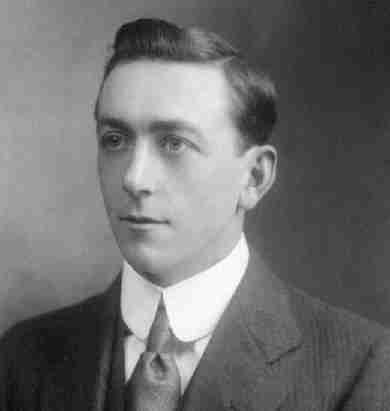<Back to Index>
- Geologist Arthur Holmes, 1890
PAGE SPONSOR

Arthur Holmes (14 January 1890 – 20 September 1965) was a British geologist. As a child he lived in Low Fell, Gateshead and attended the Gateshead Higher Grade School (later Gateshead Grammar School).
Holmes was a pioneer of geochronology, and performed the first uranium - lead radiometric dating (specifically designed to measure the age of a rock) while an undergraduate at the Royal College of Science (now Imperial College) in London, assigning an age of 370 Ma to a Devonian rock from Norway. This result was published in 1911, after his graduation in 1910. By 1911 he had already spent six months in Mozambique prospecting for minerals. While abroad he had contracted blackwater fever and malaria so severe that a note of his death was sent home by telegraph. However, he returned home and recovered – though suffering life long recurrences of the illness.
1912 saw Holmes on the staff of Imperial College, publishing his famous booklet The Age of the Earth in 1913 (he estimated the Earth's age to be 1,600 Ma). He obtained his doctorate (of Science) in 1917 and in 1920 joined an oil company in Burma as chief geologist. The company failed, and he returned to England penniless in 1924. He had been accompanied in Burma by his three year old son, who contracted dysentery and died shortly before Holmes’s departure.
In 1924 he was appointed to the newly created post of reader in
geology at Durham University. Eighteen years later his achievements were
recognized, when he became a Fellow of the Royal Society
in 1942. In the following year he was appointed to the chair of geology
at Edinburgh University, which he held until retirement in 1956.
Holmes championed the theory of continental drift promoted by Alfred Wegener at a time when it was deeply unfashionable with his more conservative peers. One problem with the theory lay in the mechanism of movement, and Holmes proposed that Earth's mantle contained convection cells that dissipated radioactive heat and moved the crust at the surface. His second famous book Principles of Physical Geology, ending with a chapter on continental drift, was published in 1944. Part of the model was the origin of the seafloor spreading concept. His later measurements of the age of the Earth (4,500 ± 100 Ma) were based on measurements of the relative abundance of uranium isotopes by Alfred O.C. Nier.
He was awarded both the Wollaston Medal and the Penrose Medal in 1956. The Arthur Holmes Medal of the European Geosciences Union is named after him.
A crater on Mars has been named in his honor.
The Durham University Department of Earth Sciences' Arthur Holmes "Isotope Geology Laboratory" is named after him, as is the students' Geology Society.